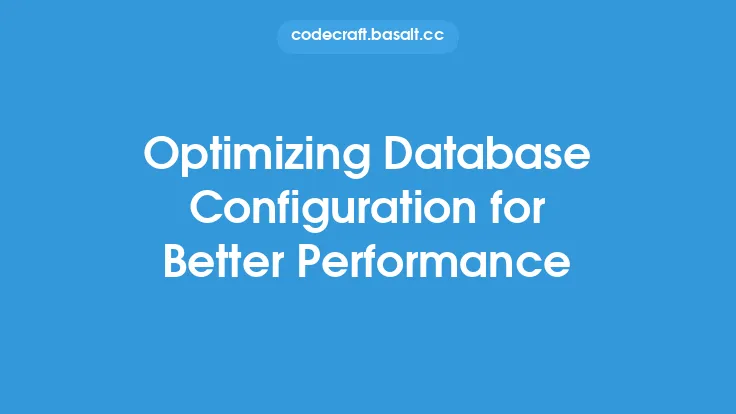When it comes to database systems, one of the most critical aspects that can significantly impact the user experience is data retrieval. The speed and efficiency at which data is retrieved from a database can make or break an application's performance. In today's fast-paced digital landscape, users expect instant access to information, and any delays can lead to frustration, abandonment, and ultimately, a loss of business. Therefore, optimizing data retrieval is essential to ensure a better user experience.
Understanding the Importance of Data Retrieval Optimization
Data retrieval optimization is crucial because it directly affects the performance of an application. When data is retrieved quickly and efficiently, users can interact with the application seamlessly, which leads to higher engagement and satisfaction. On the other hand, slow data retrieval can result in delayed page loads, unresponsive interfaces, and a general feeling of sluggishness. Moreover, as the volume of data grows, the need for optimization becomes even more pressing. Without proper optimization, databases can become bottlenecks, hindering the overall performance of the application.
Identifying Bottlenecks in Data Retrieval
To optimize data retrieval, it's essential to identify the bottlenecks in the system. These bottlenecks can occur at various levels, including the database, network, and application. Some common bottlenecks include:
- Inefficient database queries: Poorly designed queries can lead to slow data retrieval, putting a strain on the database.
- Insufficient indexing: Without proper indexing, the database has to scan the entire table to retrieve data, resulting in slower performance.
- Network latency: High network latency can delay data transmission, affecting the overall speed of data retrieval.
- Inadequate hardware: Insufficient hardware resources, such as CPU, memory, or storage, can limit the database's ability to handle requests efficiently.
By identifying these bottlenecks, developers can focus their optimization efforts on the areas that need improvement the most.
Optimizing Database Queries
One of the most effective ways to optimize data retrieval is to optimize database queries. This can be achieved by:
- Using efficient query algorithms: Choosing the right query algorithm can significantly impact performance. For example, using an index-based query can be faster than a full-table scan.
- Minimizing query complexity: Simplifying queries can reduce the load on the database, resulting in faster execution times.
- Avoiding unnecessary data retrieval: Only retrieving the necessary data can reduce the amount of data being transferred, resulting in faster performance.
- Using query optimization techniques: Techniques like query caching, query rewriting, and query optimization can help improve query performance.
Leveraging Indexing and Caching
Indexing and caching are two powerful techniques that can significantly improve data retrieval performance. Indexing allows the database to quickly locate specific data, reducing the need for full-table scans. Caching, on the other hand, stores frequently accessed data in memory, reducing the need for database queries. By leveraging indexing and caching, developers can:
- Improve query performance: Indexing can speed up query execution, while caching can reduce the number of queries needed.
- Reduce database load: By reducing the number of queries and minimizing the need for full-table scans, indexing and caching can help reduce the load on the database.
- Enhance user experience: Faster data retrieval can lead to a more responsive and engaging user experience.
Implementing Data Retrieval Optimization Techniques
To implement data retrieval optimization techniques, developers can use a variety of tools and technologies. Some popular techniques include:
- Using data retrieval frameworks: Frameworks like Hibernate and Entity Framework provide built-in optimization features, such as caching and lazy loading.
- Implementing data caching: Caching libraries like Redis and Memcached can be used to store frequently accessed data.
- Utilizing query optimization tools: Tools like Query Analyzer and SQL Server Management Studio provide features for analyzing and optimizing queries.
- Leveraging database features: Databases like MySQL and PostgreSQL provide built-in features for optimization, such as indexing and caching.
Monitoring and Maintaining Data Retrieval Performance
Optimizing data retrieval is an ongoing process that requires continuous monitoring and maintenance. To ensure optimal performance, developers should:
- Monitor database performance: Regularly monitoring database performance can help identify bottlenecks and areas for improvement.
- Analyze query performance: Analyzing query performance can help identify inefficient queries and areas for optimization.
- Update and refine optimization techniques: As the application and database evolve, optimization techniques may need to be updated and refined to ensure optimal performance.
- Test and validate optimizations: Thoroughly testing and validating optimizations can ensure that they are effective and do not introduce new issues.
Best Practices for Data Retrieval Optimization
To ensure optimal data retrieval performance, developers should follow best practices, such as:
- Keeping databases up-to-date: Regularly updating databases can ensure that they have the latest optimization features and bug fixes.
- Using efficient data structures: Using efficient data structures, such as indexes and caching, can improve data retrieval performance.
- Avoiding over-normalization: Over-normalization can lead to slower data retrieval, as it requires more joins and queries.
- Using connection pooling: Connection pooling can help reduce the overhead of creating and closing database connections.
By following these best practices, developers can ensure that their data retrieval optimization efforts are effective and efficient.
Conclusion
Optimizing data retrieval is crucial for ensuring a better user experience. By understanding the importance of data retrieval optimization, identifying bottlenecks, optimizing database queries, leveraging indexing and caching, implementing data retrieval optimization techniques, monitoring and maintaining performance, and following best practices, developers can significantly improve the performance of their applications. As the volume of data continues to grow, the need for efficient data retrieval will only become more pressing. By prioritizing data retrieval optimization, developers can create fast, responsive, and engaging applications that meet the expectations of today's users.





